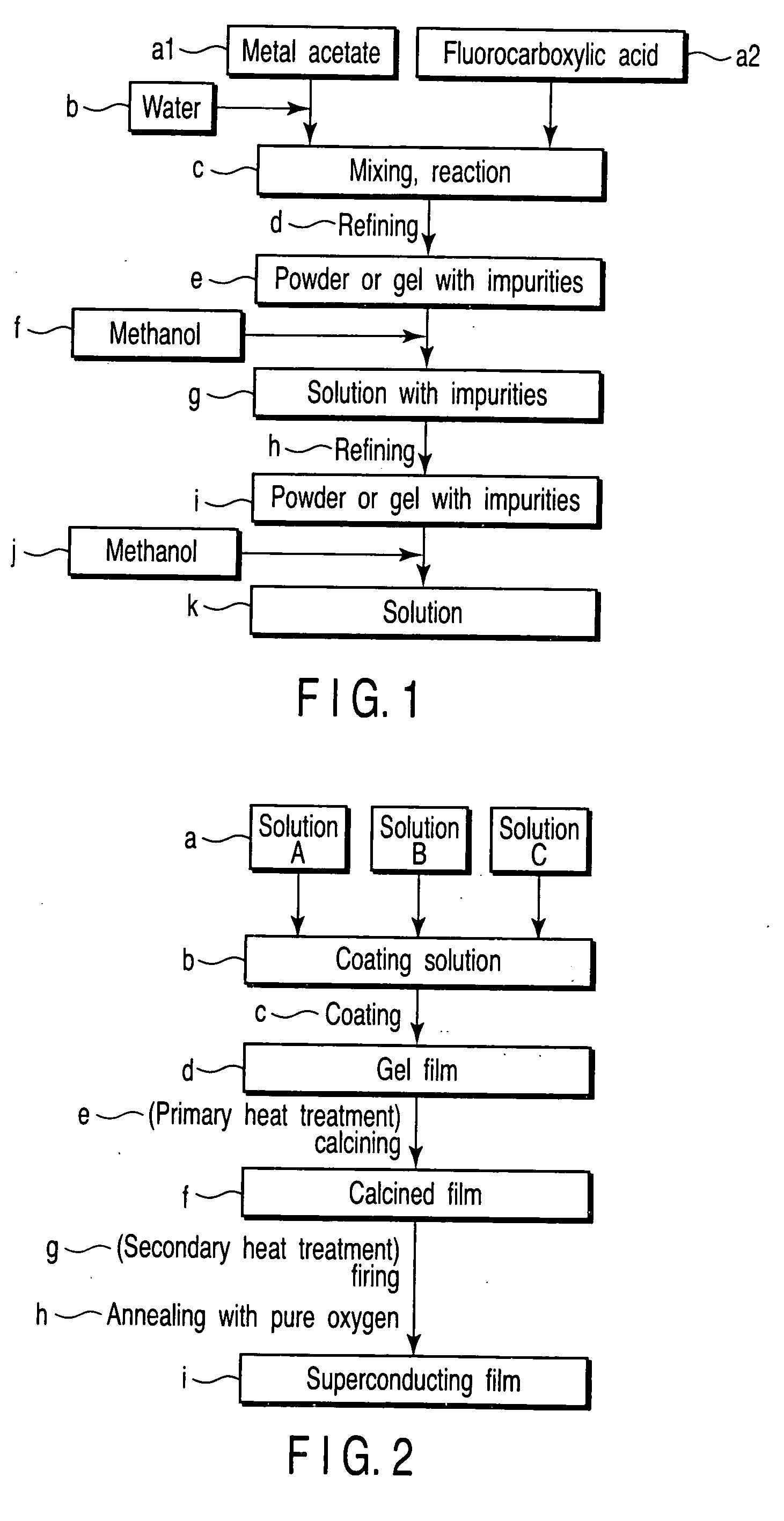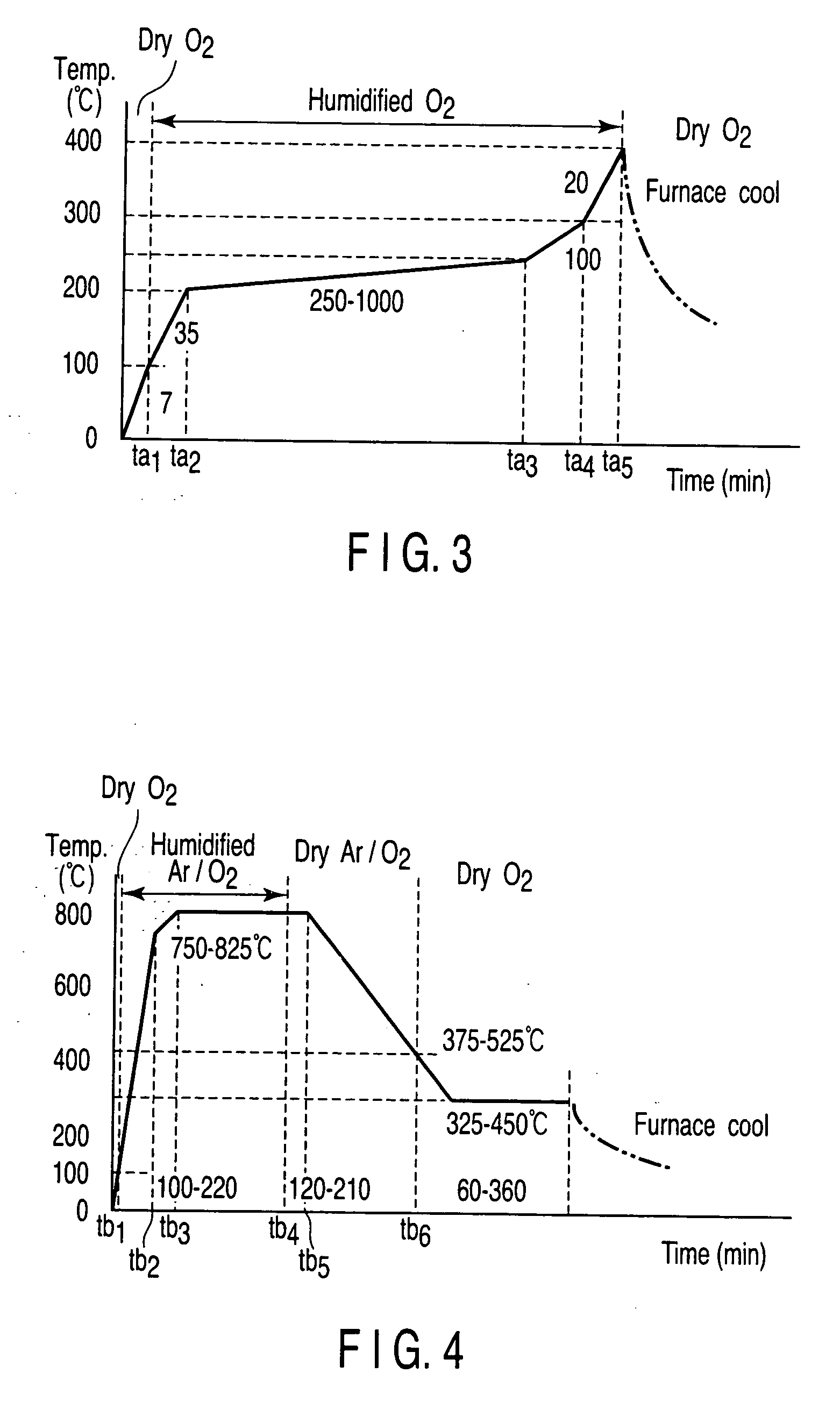Oxide superconducting film and method of preparing the same
a superconducting film and superconducting technology, applied in the direction of superconductor devices, liquid/solution decomposition chemical coatings, transportation and packaging, etc., can solve the problems of difficult preparation of superconducting films with good characteristics and high reproducibility, and difficulty in forming even films,
- Summary
- Abstract
- Description
- Claims
- Application Information
AI Technical Summary
Benefits of technology
Problems solved by technology
Method used
Image
Examples
example 1
[0081] Powder of about 3.8 hydrate of (CH3COO)3Sm was dissolved in ion-exchange water. The solution and an equimolar amount of CF3CF2COOH (PFP) were mixed and stirred in an eggplant type flask. The mixture was then reacted and refined under reduced pressure for about 10 hours with a rotary evaporator to prepare semitransparent light-yellow powder SL1app (e in FIG. 1). The powder SL1app was completely dissolved by adding methanol equivalent to a weight about 100 times thereof to prepare a yellow solution. The solution was refined again under reduced pressure for about 12 hours with a rotary evaporator to prepare opaque light-yellow powder SL1ap (i in FIG. 1). The powder SL1ap was dissolved in methanol again and diluted in a measuring flask to prepare a solution SL1a with a concentration of 0.78 mol / L in terms of metal ions (k in FIG. 1).
[0082] Powder of anhydrous (CH3COO)2Ba was dissolved in ion-exchange water, and powder of about 1.0 hydrate of (CH3COO)2Cu was also dissolved in ion...
example 2
[0092] Powder of about 3.8 hydrate of (CH3COO)3Sm was dissolved in ion-exchange water. The solution and an equimolar amount of CF3CF2COOH (PFP) were mixed and stirred in an eggplant type flask. The mixture was then reacted and refined under reduced pressure for about 10 hours with a rotary evaporator to prepare semitransparent light-yellow powder SL2app (e in FIG. 1). The powder SL2app was completely dissolved by adding methanol equivalent to a weight about 100 times thereof to prepare a yellow solution. The solution was refined again under reduced pressure for about 12 hours with a rotary evaporator to prepare opaque light-yellow powder SL2ap (i in FIG. 1). The powder SL2ap was dissolved in methanol again and diluted in a measuring flask to prepare a solution SL2a with a concentration of 0.78 mol / L in terms of metal ions (k in FIG. 1).
[0093] Powder of anhydrous (CH3COO)2Ba was dissolved in ion-exchange water. The solution and an equimolar amount of CF3COOH (TFA) were mixed and sti...
example 3
[0098] Powder of about 3.8 hydrate of (CH3COO)3Sm was dissolved in ion-exchange water. The solution and an equimolar amount of CF3CF2COOH (PFP) were mixed and stirred in an eggplant type flask. The mixture was then reacted and refined under reduced pressure for about 10 hours with a rotary evaporator to prepare semitransparent light-yellow powder SL3app (e in FIG. 1). The powder SL3app was completely dissolved by adding methanol equivalent to a weight about 100 times thereof to prepare a yellow solution. The solution was refined again under reduced pressure for about 12 hours with a rotary evaporator to prepare opaque light-yellow powder SL3ap (i in FIG. 1). The powder SL3ap was dissolved in methanol again and diluted in a measuring flask to prepare a solution SL3a with a concentration of 0.78 mol / L in terms of metal ions (k in FIG. 1).
[0099] Powder of anhydrous (CH3COO)2Ba was dissolved in ion-exchange water. The solution and an equimolar amount of CF3COOH (TFA) were mixed and sti...
PUM
| Property | Measurement | Unit |
|---|---|---|
| thickness | aaaaa | aaaaa |
| bonding angle | aaaaa | aaaaa |
| thickness | aaaaa | aaaaa |
Abstract
Description
Claims
Application Information
 Login to View More
Login to View More - R&D
- Intellectual Property
- Life Sciences
- Materials
- Tech Scout
- Unparalleled Data Quality
- Higher Quality Content
- 60% Fewer Hallucinations
Browse by: Latest US Patents, China's latest patents, Technical Efficacy Thesaurus, Application Domain, Technology Topic, Popular Technical Reports.
© 2025 PatSnap. All rights reserved.Legal|Privacy policy|Modern Slavery Act Transparency Statement|Sitemap|About US| Contact US: help@patsnap.com



